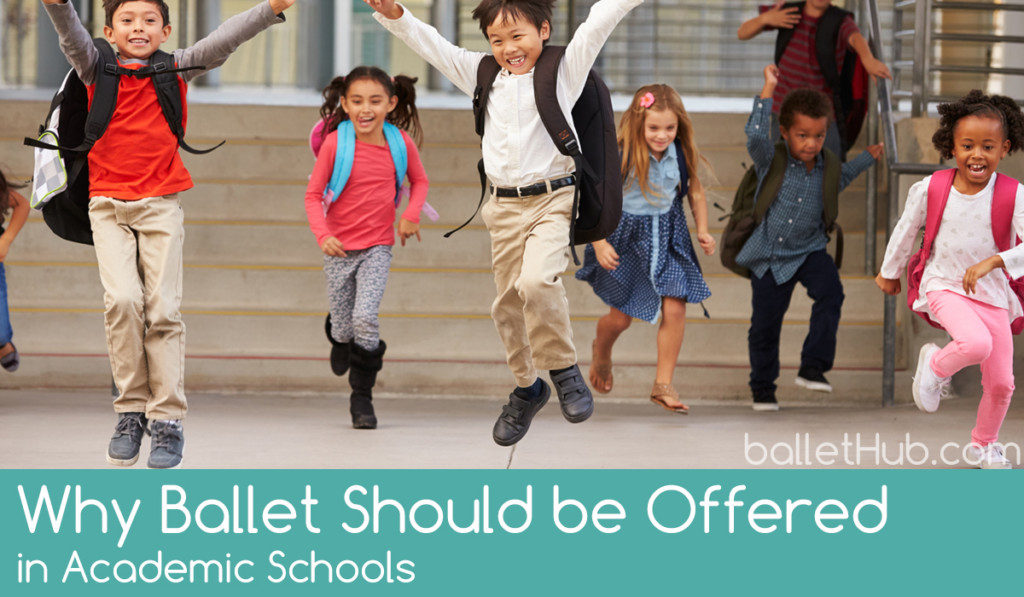Every dancer or ballet teacher can rattle off the benefits of ballet class: Besides being the place to create the foundation for and maintain your technique, the routine, commitment, and study that happens in ballet classes cements discipline, poise, and creativity as a part of every student’s demeanor. In addition to keeping the body in top form, ballet also improves cognitive acuity—in other words, it makes you smarter and able to think quickly and critically. With everyone from football teams to those trying ballet for the first time via at-home workout, ballet has become an outlet for expression, improved athleticism, and enhanced mental competency even beyond the stage and studio. So, the question remains: Why isn’t ballet in academic schools?
There isn’t much doubt that it should be, but in a country where funding for the arts is continually dwindling, especially in public schools, thousands of American students are missing out on the countless benefits that come along with your basic barre exercises. While the goal certainly isn’t to turn every third grader in the country into a ballerina, students of all ages stand to benefit from exposure to ballet. Even outside of the exceptional physical and mental benefits, being exposed to a classical art form such as ballet develops a cultured, socially and historically aware individual, someone who is engaged in and willing to embrace a world outside their own. Isn’t that everything we should want students to be?
While the benefits of arts education, in general, have gone viral on social media numerous times, the study of dance, specifically, should undoubtedly be part of the public school day. Ballet is a unique art in that it encompasses and draws upon a variety of other art forms, including music, set, and costume design, as well as spanning countless academic areas, most notably arts enrichment and physical education. The study of this one medium does so much, which means every student can gain something from exposure to it. That said, there are several key reasons that ballet barre should find a home alongside literature and math:
Increased Physical Activity & Encouragement of A Healthy Lifestyle
The physical benefits of ballet are virtually endless: It strengthens virtually every part of the body (especially the legs, core, and arms), it improves balance, stamina, coordination, concentration, flexibility, and range of motion, and all of this combined leads to a huge boost in energy.
But the benefits of ballet run deeper: Dancing leads to a reduction in anxiety and stress (something experienced by students as young as elementary school today), and embracing healthy habits. Students who are in tune with their bodies are more inclined to eat healthily and exercise, and establishing healthy habits in childhood means students are more likely to maintain that lifestyle as adults.
Team-building & Independence
It seems like the two don’t exactly go together, right? In an academic school environment, work, and life in general, being able to work as part of a team and on your own are equally important, and ballet teaches both. Being part of a piece that features a group and learning to move together creates the same spirit of working together as sports—which are popular in all schools—only with the tricky element of being unable to communicate verbally with other dancers, or your “team,” while performing.
Meanwhile, ballet also offers opportunity for introspection: You’re working on examining how your own body moves, works, and processes things. You learn to pick up steps, choreography, and combinations on your own prior to executing them together. Dancers take cues from each other, as well as working together under the direction of a teacher, making it the best of both worlds for academic students of all ages.
Intellectual & Emotional Maturity
Learning to positively channel and process your emotions is crucial to the development of a person, especially a young student. Ballet provides an outlet for expression, something that goes beyond grades or “right” and “wrong” answers. Dance helps students “engage with their own bodies, channel their energy and ignite their creative expression, which developed their confidence and self-esteem.”
It isn’t a coincidence that all of the above qualities are components aligned with high academic achievement. Simply put, dance is empowering: Memorization, attention to detail, and the development of individual perspective are created in young students from studying ballet…and aren’t those things teachers, students, and parents are attempting to encourage in academic work as well?
Arts Exposure
While we hope every kid gets to see The Nutcracker or Sleeping Beauty, the reality is that arts exposure can be limited in some families, for reasons ranging from the cost of tickets to the fact that, simply, a child’s parents may not know about ballet. This means that exposure to ballet class, or ballet demonstrations, in an academic school environment could be the only opportunity for children to develop an understanding of or interest in ballet–or even possess the knowledge that something like ballet exists!
After all, if exposure to ballet didn’t exist beyond the typical studio setting, we wouldn’t have American Ballet Theatre Principal Misty Copeland lighting up our stages. If there’s a child who is gifted or interested in ballet, they shouldn’t miss out because their parents may not have a background in the arts themselves. Furthermore, since it has been well-established that the arts benefit children in a variety of ways, we cannot limit their access due to funds, unawareness, or lack of opportunity.
Having ballet in schools ensures that every child has the chance to explore it, just as they would sports. (Even better? A child having access to ballet could end up sharing it with their entire family, too.)
Appreciation of the Performing Arts & Athleticism
Because ballet includes so many different arts within it, ballet in schools allows exposure to music and theater as well as dance, and enables students to see the various elements that go into creating a production.
In addition, exposure to ballet displays an alternative side to athleticism: While when most students think “athlete,” sports come to mind, ballet demonstrates how active bodies move in different ways, which offers new perspective on old stereotypes.
Despite this, ballet in schools remains a fairly heavy debate, with some saying the study of ballet isn’t compatible with the environment of schools, and should be reserved for studio and “serious” students instead. Share your thoughts: Does ballet belong in the classroom?

